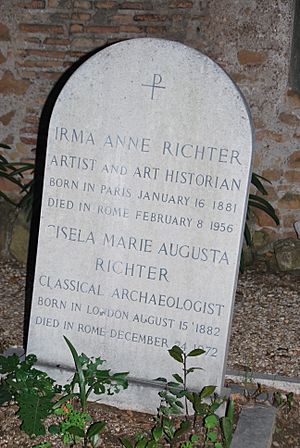Gisela Richter facts for kids
Gisela Marie Augusta Richter (born August 14 or 15, 1882 – died December 24, 1972) was a very important expert in ancient art and history. She studied and wrote about the art of ancient Greece and Rome. She was a leading figure in her field.
Early Life and Education
Gisela Richter was born in London, England. Her parents, Jean Paul and Louise Richter, were also art historians, just like her sister Irma. They specialized in Italian Renaissance art.
Gisela went to Maida Vale School, which was a top school for girls at the time. She decided to become an expert in ancient art after listening to lectures by Emmanuel Loewy at the University of Rome around 1896.
In 1901, she started studying at Girton College at the University of Cambridge. At that time, women could not officially graduate from Cambridge, so Richter left in 1904 without a degree. She then spent a year studying at the British School at Athens in Greece from 1904 to 1905. In 1905, Richter moved to the United States and became an American citizen in 1917.
Career at the Met
In 1905, Richter joined the Metropolitan Museum of Art (often called "the Met") in New York City as an assistant. Her first big task was to create a list and description (a catalogue) for a new collection of ancient Greek vases. These vases had been bought from famous art dealers called the Canessa Brothers.
She quickly moved up in her career:
- In 1910, she became an assistant curator.
- In 1922, she was promoted to associate curator.
- In 1925, she became the curator of Greek and Roman art. This was a very important role, and she was the first woman to hold the title of 'curator' at the Met.
Richter stayed in this position until she retired in 1948. Even after retiring, she continued to work as an honorary curator until she passed away in 1972. As a curator, she was one of the most influential people studying classical art history at that time.
Teaching and Awards
Gisela Richter also shared her knowledge by teaching at several universities, including Columbia University, Yale University, Bryn Mawr College, and Oberlin College.
She wrote many popular books about ancient art. These books helped many people learn about and enjoy the art of ancient Greece and Rome.
Richter received several important awards for her work:
- In 1944, she got the Achievement Award from the American Association of University Women.
- In 1952, she was given an honorary Doctor of Letters degree by the University of Oxford in England.
- In 1968, she received the Gold Medal Award for Distinguished Archaeological Achievement from the Archaeological Institute of America.
In 1942, she was also chosen as a member of the American Philosophical Society, a very old and respected group of scholars.
Death and Legacy
In 1952, Gisela Richter moved to Rome, Italy, where she lived until her death on December 24, 1972. She is buried in Rome's Cimitero acattolico, which is a non-Catholic cemetery.
Many years after her death, a writer named Camille Paglia praised Richter for her clear thinking, careful observation, and deep understanding of art and design. Gisela Richter left behind a great legacy through her work at the Met, her many books, and her influence on how people understood ancient art.
See also
 In Spanish: Gisela M. A. Richter para niños
In Spanish: Gisela M. A. Richter para niños


